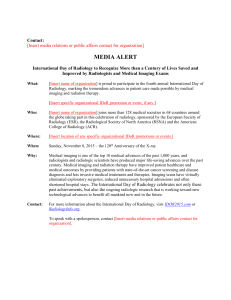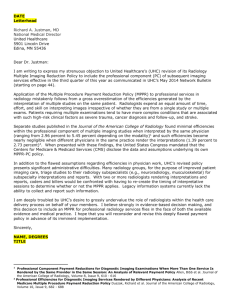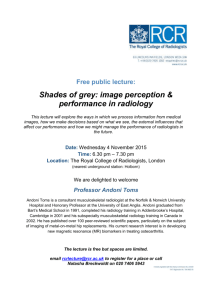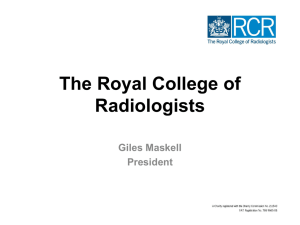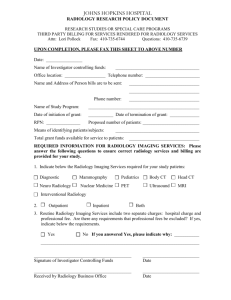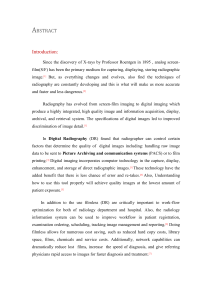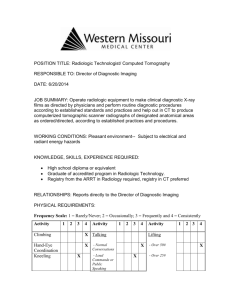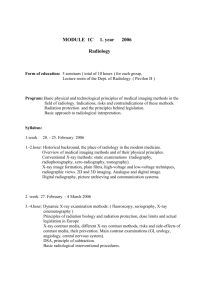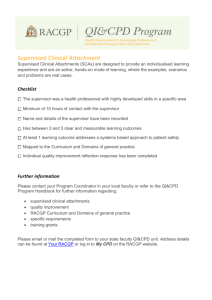Version - Word 243 KB - Department of Health
advertisement
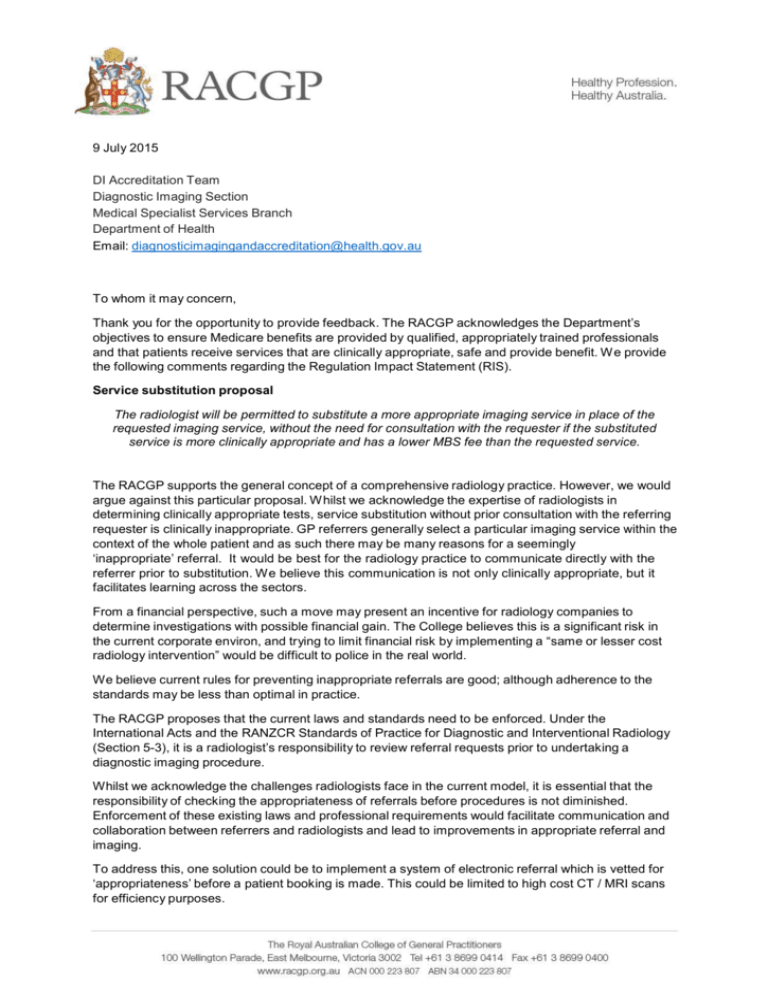
9 July 2015 DI Accreditation Team Diagnostic Imaging Section Medical Specialist Services Branch Department of Health Email: diagnosticimagingandaccreditation@health.gov.au To whom it may concern, Thank you for the opportunity to provide feedback. The RACGP acknowledges the Department’s objectives to ensure Medicare benefits are provided by qualified, appropriately trained professionals and that patients receive services that are clinically appropriate, safe and provide benefit. W e provide the following comments regarding the Regulation Impact Statement (RIS). Service substitution proposal The radiologist will be permitted to substitute a more appropriate imaging service in place of the requested imaging service, without the need for consultation with the requester if the substituted service is more clinically appropriate and has a lower MBS fee than the requested service. The RACGP supports the general concept of a comprehensive radiology practice. However, we would argue against this particular proposal. W hilst we acknowledge the expertise of radiologists in determining clinically appropriate tests, service substitution without prior consultation with the referring requester is clinically inappropriate. GP referrers generally select a particular imaging service within the context of the whole patient and as such there may be many reasons for a seemingly ‘inappropriate’ referral. It would be best for the radiology practice to communicate directly with the referrer prior to substitution. We believe this communication is not only clinically appropriate, but it facilitates learning across the sectors. From a financial perspective, such a move may present an incentive for radiology companies to determine investigations with possible financial gain. The College believes this is a significant risk in the current corporate environ, and trying to limit financial risk by implementing a “same or lesser cost radiology intervention” would be difficult to police in the real world. We believe current rules for preventing inappropriate referrals are good; although adherence to the standards may be less than optimal in practice. The RACGP proposes that the current laws and standards need to be enforced. Under the International Acts and the RANZCR Standards of Practice for Diagnostic and Interventional Radiology (Section 5-3), it is a radiologist’s responsibility to review referral requests prior to undertaking a diagnostic imaging procedure. Whilst we acknowledge the challenges radiologists face in the current model, it is essential that the responsibility of checking the appropriateness of referrals before procedures is not diminished. Enforcement of these existing laws and professional requirements would facilitate communication and collaboration between referrers and radiologists and lead to improvements in appropriate referral and imaging. To address this, one solution could be to implement a system of electronic referral which is vetted for ‘appropriateness’ before a patient booking is made. This could be limited to high cost CT / MRI scans for efficiency purposes. Comments on other proposed solutions The RACGP would support a practice based approach to diagnostic imaging (option 3). We suggest altering the definition of a comprehensive practice to ones that “provides and performs services at a minimum set level.” The rural exemptions outlined are reasonable, but we believe a transition period needs to be included to ensure practices in rural and remote areas are not inadvertently disadvantaged. The RACGP has no issues with changes to ultrasound (US) requirements. The RACGP notes increasing use of US as a routine part of examination in some specialist cases, and would support this being incorporated into consultation fees. W e would also support time-based US report payments. Other comments One issue not considered in the RIS, is the level of corporatised health services in Australia and its impact on the objectives outlined in the RIS. This issue has been previously raised by Medicare in a 2012 report - State of Corporatisation: A report on the corporatisation of general practices in Australia.1 The report states “The real value of general practice, at least to some listed corporations, is not in general practice per se, but its ability to generate referrals.” We would particularly like to draw attention to corporates with mixed general practice, radiology, and pathology services. The claim in the report is that these vertically integrated corporates are driving radiology expenditure via GP referrals.2 This claim is supported by reports of incentives to radiologists.3 The RACGP believes the Department of Health should seriously consider reviewing the funding mechanisms of corporates particularly those with vertically integrated models. This would include a review of: 1. 2. 3. Funding for capital infrastructure. Particularly in instances where capital is easily obtained from the market by these companies, as well as additional capital funding available under the PIP program to general practices. Radiology Medicare payments and existing regulation. Consideration should be given to reducing radiology Medicare payments or applying additional regulatory restrictions to address and manage businesses generating internal referrals to maximise radiology incomes. Cost shifting by public corporates – i.e. State hospital systems driving radiology expenditure. Yours sincerely Dr Frank R Jones RACGP President. References 1. State of Corporatisation A report on the corporatisation of general practices in Australia Medicare Financing and Analysis Branch Department of Health and Ageing February 2012 2. 3. Jones, J., 2007, “Integration and diversification in healthcare: Financial performance and implications for Medicare”, Health Sociology Review, Volume 16, Issue 1, April 2007, pp27‐42. ABC News “Primary Health Care investigated over claims it offered incentives to radiologists that may have led to overservicing” Accessed 12 June 2015, http://www.abc.net.au/news/2014-10-31/claims-doctors-offered-incentives-to-overservice/5855504
